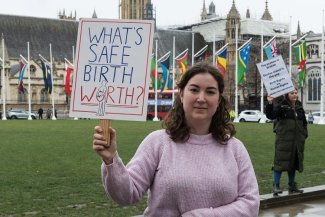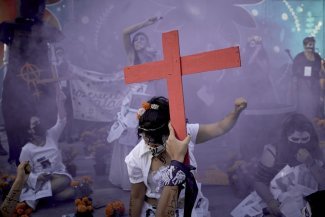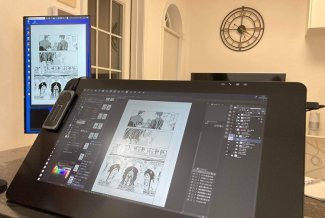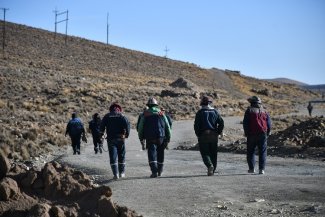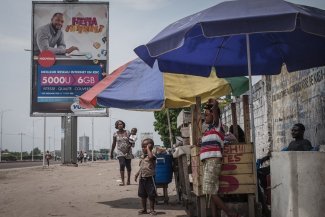
Young people in Saudi Arabia, who often study abroad and use social media at one of the highest rates in the world, want to live in more open and modern country. Jeddah, Saudi Arabia, 2010.
“I studied English literature and work as a freelance translator. I’m single and I live away from my parents’ home with another girl in a shared flat. I’m a young women trying to live an independent life,” 23-year-old Zahra Roshanaie of Tehran describes herself to Equal Times.
“I’m in my third year of studying psychology. I’d like to finish my studies abroad and find a job in a hospital or a clinic. I’m signing up to get my driving license soon. It’s so exciting!” says Maria Saleema (whose name was changed to protect her identity), a 21-year-old Saudi from the eastern city of Jeddah.
Zahra and Maria don’t know each other. They are citizens of the two opposing powers of the Middle East, Shia Iran and Sunni Saudi Arabia. Both women represent the unstoppable changes taking place in their respective countries, which have imposed by force the strictest forms of Islamic orthodoxy to oppress their populations, particularly women.
For decades, Iran and Saudi Arabia have positioned themselves as two of the most conservative and hermetic countries in the Middle East, one ruled by the Ayatollahs since the overthrow of the pro-Western Shah in the 1979 Islamic Revolution, the other by the authoritarian Saud family, proponents of Wahhabism, one of the strictest forms of Sunni Islam. In recent years, however, cracks have begun to appear in the walls isolating both countries and a wave of modernity has resulted in greater rights for their citizens. Relaxation in the use of the compulsory veil in Iran, the opening of cinemas and opera houses for the first time in decades in Saudi Arabia, less segregation of the sexes and increased presence of women in public spaces are some of the most visible examples of the changes taking place.
“I don’t like to use the word liberalisation, because it hasn’t really happened, or at least for the time being it’s only superficial,” says Ángeles Espinosa, a veteran Middle East correspondent for the Spanish daily El País who lived in Iran for more than five years and regularly travels to Saudi Arabia.
As she explains, the laws have not significantly changed in Iran; instead, society has changed its behaviour, forcing authorities to turn a blind eye. In Saudi Arabia, reforms have been imposed from above and represent an attempt to diversify the economy rather than a real desire for change. Nonetheless, “it’s true that important transformations are taking place in both societies,” she says.
The high level of education of the middle classes, changing economic dynamics that are forcing a new production model more open to the outside world, and the young people of both countries have made it necessary to adapt past structures. At the same time, access to information and connectivity with the outside world have nurtured aspirations for greater individual freedom. If the arrival of satellite television in the Middle East and the Maghreb facilitated access to a greater plurality of information, for young people as well as the economically disadvantaged and the elderly, widespread internet access and the explosion in the use of social networks have fuelled a more critical mentality and a desire for modernity. “The authorities have tried to control social change but they have been overwhelmed by it,” says Espinosa.
Iran, a society advancing faster than its leaders
On the 40th anniversary of the Islamic Revolution of Iran, which resulted in the imposition of strict religious codes onto every aspect of public and private life in the Republic, changes in the daily habits and customs of Iranians can be seen. In the capital city of Tehran and in other major Iranian cities, the number of cafes and cultural spaces are multiplying, many of them mixed gender. The black veils inextricably linked with the Shia country in the Western imagination have given way to a revolution of colour. Women both young and old wear colourful printed scarves placed on the crowns of their heads, revealing much of their hair. Jeans and tight-fitting clothing can be glimpsed under the long jackets required to hide their figures. Last year a group of women initiated a campaign against the hijab, posting photos of themselves online with their heads uncovered. Some women, still very few in numbers, can even be seen walking the streets of the capital with their hair blowing in the wind.
With 40 million active users (half of the country’s population) of the encrypted messaging service Telegram and 30 million Instagram users, modern-day Iran is a country hooked on social media. Although Twitter is banned, many MPs have their own accounts on the messaging platform. Restrictions on online applications and new sites can easily be circumvented using virtual private networks (VPN) that allow for secure connections. The advent of 4G technology and the opening of the market to new providers, driven by current president Hasan Rohani, have lowered prices and resulted in an increase in new technologies.
“Social networks have had a major impact on people’s lives,” says Zahra. “When something doesn’t appear on official television, you look for it on Instagram, you can find everything on there now. People post comments and criticism. It’s helping to educate people, on women’s rights for example. People are more open than they used to be,” she says.
After the harsh repression that followed the Green Revolution of 2009 (massive protests in response to the alleged electoral fraud that took place against reformist candidate Mir Mousavi), the movement for civil rights has transformed into something much more widespread. “Now the focus is on changing social norms rather than demanding more democracy with far-reaching political changes,” says Tara Sepehri, a researcher with Human Rights Watch who specialises in Iran. As a result, the demands of the civil rights movement “have been joined by the educated, not necessarily activist urban middle classes pushing for progress.”
In addition to religious restrictions, the population of Iran is suffering from a disastrous economic situation aggravated by sanctions imposed by the United States and growing pressure exerted by the White House. According to estimations by the International Monetary Fund (IMF), the Iranian economy could contract by up to 6 per cent this year, the worst figure since 2012. Sky-high inflation and continued devaluation of the rial are straining the purchasing power of the lower and middle classes. It has thus been in the authorities’ interest to relieve pressure where they can. “We’re fed up with their rules and the bad economic situation. That’s why they allow us certain freedoms. They know that any more pressure would make the people explode,” says Zahra.
One example is the greater permissiveness shown by the religious police, who are increasingly less likely to interfere in relations between the sexes. Alcohol, officially forbidden in Iran, is easily obtained on the black market and many people consume it at home and at social events such as wedding celebrations. And while family laws continue to discriminate heavily against women, couples increasingly add clauses to marriage contracts that guarantee equal rights to both spouses in matters such as divorce and parental custody and eliminate the requirement that women obtain their husbands’ permission to travel outside the country. “These are private contracts so the government can’t prevent them,” says Sehperi.
Despite the fact that the laws and official rhetoric have hardly changed over the last four decades, younger generations, increasingly educated and connected to the outside world, are demanding greater freedoms and the regime has no choice but to adapt to this new social reality. “They can’t stop us anyhow, there’s too many of us,” says Zahra.
Saudi Arabia: change from above
The winds of change in Saudi Arabia are blowing from a different direction. The ambitious programme Vision 2030, a personal project of Crown Prince Mohammad bin Salman, aims to rapidly modernise the Saudi economy through innovation, digitisation and artificial intelligence. The plan calls for an expansion of the tourism sector beyond religious tourism and increased investment in the entertainment industry in order to boost domestic consumption and attract international investors. As part of this programme, the Wahhabi kingdom has for the first time allowed the opening of cinemas and opera houses and authorised concerts and other cultural events.
The most important changes taking place concern the rights of women. Long one of the most misogynistic countries in the world, Saudi Arabia has begun to grant women access to professions previously reserved for men. Certain important positions are now occupied by women such as Reema bin Bandar al Saud, recently named as ambassador to the United States, and Sarah Al Suhaimi, president of the Saudi Stock Exchange since 2017. However, the most symbolically important breakthrough was the law passed in June of last year that gives women the right to drive.
“The authorities aren’t stupid. They know that the days of oil are numbered and that in a few years renewable energies will make their main source of income obsolete. So they need a new model in which women participate in the economy. And to do that they have to be able to drive,” says Espinosa, author of El Reino del Desierto: Arabia Saudí frente a sus contradicciones (The Desert Kingdom: Saudi Arabia in the face of its contradictions).
The Crown Prince has also called for a more moderate version of Islam, a first in Saudi Arabia. It has become increasingly common for women and men to be seen interacting in offices and shopping centres, where strict gender segregation was previously imposed. In a recent interview, bin Salman surprised observers by saying that wearing the veil should not be compulsory.
In a country where 70 per cent of the population is under 30, bin Salman, himself in his thirties, is rapidly gaining support. Young Saudis, who often study abroad and use social media at one of the highest rates in the world, want to live in a more open and modern country.
But many view these recent reforms as merely cosmetic changes when it comes to women’s rights. The country still has a system of male guardianship that infantilises women for life by requiring authorisation from a man in their family (father, brother or husband) to travel, work, open a bank account or even get out of prison. Proof of the oppressive nature of the system can be seen in the hundreds of young people who flee the country every year in an attempt to gain their freedom. Despite the recent law allowing women to obtain driving licenses, dozens of feminist activists remain imprisoned for demanding that very same right prior to the reform.
According to NGOs, the country’s human rights situation generally remains appalling, with thousands of imprisoned dissidents and one of the highest numbers of state executions in the world. The murder of opposition journalist Jamal Khashoggi, widely reported in the media, was a reminder of the darker side of the Wahhabi regime.
“The rights that we’ve been given are fine, but we also want the freedom to talk about politics. Human rights aren’t respected here. If we talk, they put us in prison,” says Saleema. A member of the country’s Shia minority, she has experienced this first hand: her father was imprisoned and sentenced to death on charges of spying for Iran (on 23 April, after this interview was conducted, Equal Times received confirmation that Saudi authorities had executed Saleema’s father along with 36 other men, mostly Shia). Saudi Arabia’s religious minorities, including Shia and Sufis (the mystical branch of Islam) continue to be persecuted by the regime. “Many point out that bin Salman wants to follow the Chinese model of opening up his country economically while maintaining political control,” says Espinosa.
This mixture of granting certain freedoms while maintaining authoritarian control also applies to Iran, where authorities have relaxed their stance on social norms while continuing to repress the feminist movement and the labour movement. In 2018, 7,000 people including students, activists, members of minority groups and journalists were arrested, about 30 executed, and several hundred given harsh prison sentences.
In both countries, young people and women have become the main drivers of change. “In these extremely authoritarian, patriarchal and hierarchical societies, women are the ones with the most to lose,” says Espinosa. “Regardless of the social and political events that take place in the years to come, progress is a reality from which there is no turning back.”



